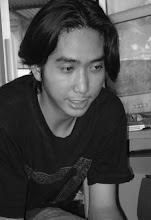- Create efficient application software for specific processing needs
User
- Understand system capabilities and limitations
- Make informed decisions
- Improve communications with information technology
professionals
Systems Analyst
- Conduct surveys, determine feasibility and define and
document user requirements
- Specify computer systems to meet application requirements
Sabtu, 15 November 2008
System Administrator / Manager
- Install, configure, maintain, and upgrade computer systems
- Maximize system availability
- Optimize system performance
- Ensure system security
- Maximize system availability
- Optimize system performance
- Ensure system security
Web Designer
- Optimize customer accessibility to Web services
- System administration of Web servers
- Select appropriate data formats
- Design efficient Web pages
- System administration of Web servers
- Select appropriate data formats
- Design efficient Web pages
Input-Process-Output Model (IPO)
- Input: keyboard, mouse, scanner, punch cards
- Processing: CPU executes the computer program
- Output: monitor, printer, fax machine
- Storage: hard drive, optical media, diskettes, magnetic tape
- Processing: CPU executes the computer program
- Output: monitor, printer, fax machine
- Storage: hard drive, optical media, diskettes, magnetic tape
Architecture Components
- Hardware
- Processes data by executing instructions
- Provides input and output
- Software
- Instructions executed by the system
- Data
- Fundamental representation of facts and observations
- Communications
- haring data and processing among different systems
- Processes data by executing instructions
- Provides input and output
- Software
- Instructions executed by the system
- Data
- Fundamental representation of facts and observations
- Communications
- haring data and processing among different systems
Hardware Component
- Input/Output devices
- Storage Devices
- CPU
- ALU: arithmetic/logic unit
- CU: control unit
- Interface unit
- Memory : Short-term storage for CPU calculations
- Storage Devices
- CPU
- ALU: arithmetic/logic unit
- CU: control unit
- Interface unit
- Memory : Short-term storage for CPU calculations
CPU: Central Processing Unit
- ALU: arithmetic/logic unit : Performs arithmetic and Boolean logical calculations
- CU: control unit : Controls processing of instructions, Controls movement of data within the CPU
- Interface unit
- Moves instructions and data between the CPU and other hardware components
- Bus: bundle of wires that carry signals and power between different components
- CU: control unit : Controls processing of instructions, Controls movement of data within the CPU
- Interface unit
- Moves instructions and data between the CPU and other hardware components
- Bus: bundle of wires that carry signals and power between different components
Software Component
- Applications
- Operating System : API: application program interface, File management, I/O, Kernel : Memory management, Resource scheduling, Program communication, Security
- Network Module
- Operating System : API: application program interface, File management, I/O, Kernel : Memory management, Resource scheduling, Program communication, Security
- Network Module
Communications Component
- Hardware
- Communication channels : Physical connections between computer systems, Examples: wire cable, phone lines, fiber optic cable, infrared light, radio waves
- Interface hardware : Handles communication between the computer and the communication channel, Modem or network interface card (NIC)
- Software
- Network protocols: HTTP, TCP/IP, ATAPI
- Communication channels : Physical connections between computer systems, Examples: wire cable, phone lines, fiber optic cable, infrared light, radio waves
- Interface hardware : Handles communication between the computer and the communication channel, Modem or network interface card (NIC)
- Software
- Network protocols: HTTP, TCP/IP, ATAPI
Computer Systems
All computer systems, no matter how complex, consists of the following:
- At least one CPU
- Memory to hold programs and data
- I/O devices
- Long-term storage
- At least one CPU
- Memory to hold programs and data
- I/O devices
- Long-term storage
Protocols
- Common ground rules of communication between computers, I/O devices, and many software programs
- Examples : HTTP: between Web servers and Web browsers, TCP/IP: between computers on the Internet and local area networks, ATAPI: between a CPU and CD-ROMs
- Examples : HTTP: between Web servers and Web browsers, TCP/IP: between computers on the Internet and local area networks, ATAPI: between a CPU and CD-ROMs
Standards
- Created to ensure universal compatibility of data formats and protocols
- May be created by committee or may become a de facto standard through popular use
- Examples : Computer languages: Java, SQL, C, JavaScript, Display standards: Postscript, MPEG-2, JPEG, GIF, Character set standards: ASCII, Unicode, EBCDIC, Video standards: VGA, XGA, RGB
- May be created by committee or may become a de facto standard through popular use
- Examples : Computer languages: Java, SQL, C, JavaScript, Display standards: Postscript, MPEG-2, JPEG, GIF, Character set standards: ASCII, Unicode, EBCDIC, Video standards: VGA, XGA, RGB
Langganan:
Postingan (Atom)
Early History
- 1642: Blaise Pascal invents a calculating machine
- 1801: Joseph Marie Jacquard invents a loom that uses punch cards
- 1800’s : Charles Babbage attempts to build an analytical engine (mechanical computer), Augusta Ada Byron develops many of the fundamental concepts of programming, George Boole invents Boolean logic.
- 1937: Mark I is built (Aiken, Harvard University, IBM) : First electronic computer using relays.
- 1939: ABC is built : First fully electronic digital computer. Used vacuum tubes.
- 1943-46: ENIAC (Mauchly, Eckert, University of Pennsylvania) : First general purpose digital computer.
- 1945: Von Neumann architecture proposed : Still the standard for present day computers.
- 1947: Creation of transistor : (Bardeen, Shockley, Brattain, Bell Labs).
- 1951: UNIVAC
First commercially available computer.
Copyright 2003 John Wiley & Sons
3rd Edition, Irv Englander
John Wiley and Sons Ó2003
Wilson Wong, Bentley College
Linda Senne, Bentley College
